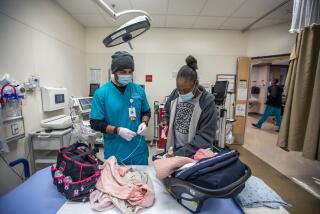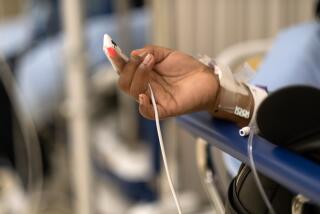Preventable Hospital Infections Becoming a Deadly Epidemic
Deadly infections fueled by poor sanitation, contaminated instruments and unwashed hands in the nation’s hospitals are needlessly claiming tens of thousands of lives annually, according to an investigation by the Chicago Tribune.
While the hospital industry often characterizes deaths by infection as random and unavoidable, the Tribune, in the first comprehensive analysis of patients’ deaths linked to infection in 5,810 hospitals across the nation, found otherwise. Not only are many deaths by infection easily preventable, the newspaper said, but soaring infection rates also have been exacerbated by hospital budget cutbacks in infection control staffs and housekeeping services.
The problem has grown so severe that deaths linked to hospital germs now represent the fourth leading cause of mortality among Americans, behind heart disease, cancer and strokes, according to the Centers for Disease Control and Prevention. Infections connected to hospital-based germs kill more people annually than auto accidents, fires and drowning combined.
“The number of people needlessly killed by hospital infections is unbelievable, but the public doesn’t know anything about it,” said Dr. Barry Farr, a leading infection-control expert and president of the Society for Healthcare Epidemiology of America.
“For years, we’ve just been quietly bundling the bodies of patients off to the morgue while infection rates get higher and higher.”
Infections that would be no problem for healthy people can become fatal for hospital patients who are too old or too weak to fend them off.
The Tribune’s analysis, which adopted methods commonly used by epidemiologists, found an estimated 103,000 deaths linked to hospital infections in 2000. The CDC, which bases its numbers on extrapolations from 250 hospitals, estimated there were 90,000 that year. Though the CDC does not attempt to classify any infections as preventable, the Tribune examined federal health inspection reports and other public documents in all 50 states to make its analysis. The paper found that in 2000--the latest year health-care records were available nationally--75,000 of the deadly hospital infections took place in conditions that were preventable.
The Tribune investigation uncovered disturbing and largely unreported cases of fatal infections that might have been avoided had hospitals held themselves and their staffs to adequate sanitation standards.
In a Detroit hospital, as doctors and nurses moved about the pediatric intensive care unit without washing their hands, a germ killed four babies in the same row of bassinets in the spring of 1997, according to interviews and court records. It took two full months for administrators to close the nursery for cleaning.
Staphylococcus germs, common on the skin and in nasal passages, infected more than 100 cardiac patients at a West Palm Beach, Fla., hospital over the last four years, killing 13 of them. The survivors underwent agonizing surgeries and long rehabilitation periods as rotting bone was cut from their bodies.
Eight Chicago children died in 1998 as germs from a South Side pediatric medicine center spread into a hospital. Fever-ridden health-care workers who tended to patients spread the germs, as did other workers who failed to wash their hands. The outbreak was stopped months later after 36 workers, some with fevers and sickness, were ordered to stay home.
The rare bacteria found in Chicago has since been linked to the deaths of dozens of children in medical facilities in three states.
Hospitals are not legally required to disclose infection rates, and most don’t. Doctors are not required to tell patients about risk or exposure to hospital germs. There is little government oversight in the area of infection in hospitals, which combines with the industry’s long-apparent penchant for secrecy to hide the problem.
The problems stretch far beyond isolated cases in specific hospitals. The Tribune’s investigation found systemic problems pointing to abysmal infection-control efforts across the nation:
* Life-threatening violations of infection-control standards are common in hospitals. Since 1995, the investigation showed, 75% of all U.S. hospitals have been cited for serious cleanliness and sanitation violations.
* In thousands of cases, surgeons performed operations without washing their hands or wearing surgical masks. In one case, records show, surgeries were performed in a Connecticut operating room even while dust floated in the air and flies buzzed overhead during open-heart surgery.
* Hospital cleaning staffs are overwhelmed and inadequately trained, which leads to unsanitary areas where germs can grow and multiply, sometimes for years. Since 1995, hospital cleaning staffs have been cut by 25%. In that same period, almost half of all hospitals have been cited for failure to properly sanitize their facilities.
* Rampant payroll cutbacks have gutted staffs devoted to reducing infections. These staffs have been cut by an average of 20% nationally in the last three years. A majority of hospitals ignores the CDC’s recommendation that hospitals have one infection-control person for every 250 beds.
Budget cutbacks are cited as one reason infections are on the rise in the nation’s hospitals. Nurses report their hospitals are so understaffed that they don’t always have time to wash their hands between patient visits.
The problem is not likely to go away. The American Hospital Assn. predicts further cutbacks in staff and patient care, leading to more infection-control problems.
About 1,700 American hospitals, about a third of the total, are operating at a loss. An equal number are on the edge of bankruptcy, the AHA reports.
At Bridgeport Hospital in Bridgeport, Conn., germs flourished in areas that are supposed to be the most sterile places in the hospital, according to a review of thousands of pages of hospital records collected in a lawsuit and opened for public inspection by the Connecticut Supreme Court last year.
The court case involved four patients who contracted infections inside the hospitals. Operating Room No. 2, where one in five patients at times contracted infections, epitomized the hospital’s problem. The air was often contaminated by dust because of faulty ventilation. Flies buzzed overhead during operations. Doctors wore germ-laden clothes from home into the operating room. Many did not wash their hands before operating.
“Bridgeport had a long history of high infection rates but corrective action was not taken until it was too late,” said Peggy Haering, an attorney who represented a patient in a suit settled out of court. “What became clear is that these infections were preventable.”
“Nobody here intentionally spread germs, but we’ve learned that even the smallest breakdown in infection control can have devastating consequences,” said hospital spokesman John Capiello. The hospital has undergone a $30-million remodeling. Infection rates have dropped to nearly zero.
The hospital-monitoring system is a checkerboard of local, state and federal regulators who do little to encourage better infection control. All hospitals must have general standards to quality for the federal Medicaid program, but each facility is allowed to draft its own rules.
“Can you imagine the medical community outcry if even a single doctor died from germs because of a failure to wash hands?” asked Mark Bruley, a forensic investigator who studies hospital conditions for ECRI, a nonprofit laboratory near Philadelphia.






